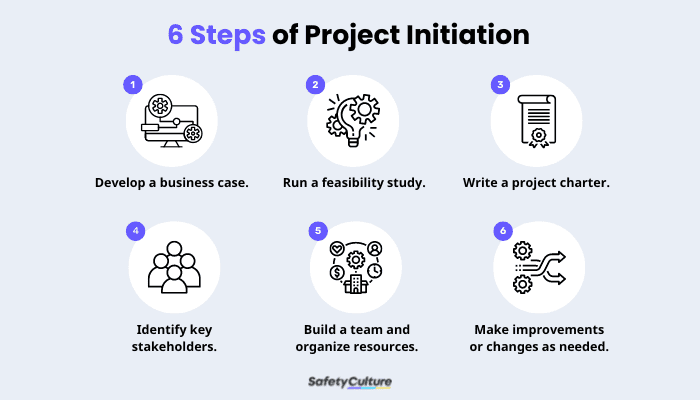What is Project Initiation?
Project initiation is the first phase in the project management system wherein a new project is recognized, its need is established, and its business value is identified. These outputs are used to acquire buy-in from key stakeholders and have the go signal for the project to commence. After this stage, the process goes through the next steps: planning, execution, monitoring and control, and closure.
Project Initiation vs. Project Planning
Since project initiation is the first phase, many confuse its difference from project planning. It’s important to remember that project initiation comes first because even before a project goes through the project planning stage, an organization must establish its business value before gathering the resources, people, and other requirements for successful project execution.
Why is Project Initiation Important?
Aside from the fact that project initiation is the first step in the overall project management system according to the Project Management Institute (PMI), this phase is key to ensuring an idea or project can really add value to the objectives of the organization as well as its goals in meeting customer needs before even proceeding to plan it out. Since project initiation aims to create a structured approach to lay down the project’s business case, it’s essential to conduct this stage for the stakeholders to be involved in the process early on and improve the overall step-by-step execution of the project.
What are the Steps in Project Initiation?

6 Steps of Project Initiation
The project initiation process may slightly vary from one organization to another depending on its industry or business type. Nonetheless, you can consider following these 6 common project initiation steps:
1. Develop a business case.
This step is where you and your team determine why starting or completing the project is needed and how it can benefit the organization. A business case justifies why a project must be undertaken or launched and provides a concrete evaluation of the cost, risks, and benefits associated with the project.
As part of your project initiation checklist, a business case must have important elements including but not limited to the following, as stated by James Cook University Australia:
- Executive summary
- Background information
- Project definition
- Business requirements
- Presentation and evaluation of options
- Strategic alignment
- Benefits and risks
- Project implementation plan
- Financial analysis
- Needed resources
- Authorizations
- Appendices
Check out these ready-to-use checklists and templates to help you develop and analyze your business case:
- Business Case Template
- Simple Business Case Template
- Project Business Case Template
- Business Case Proposal Template
- Business Case Analysis Template
2. Run a feasibility study.
One of the main outputs during the initiation phase of a project is a feasibility study or document. Once the senior leadership or management of your organization has approved the project’s business case, the next step is to study whether the project can succeed.
It’s crucial for you to take into consideration factors such as the availability of resources (or lack thereof), the capacity of your organization to carry out the project, and the costs associated with it during this step.
3. Write a project charter.
Considered the most important output of project initiation, a project charter aims to help you delve deeper into the project by answering the following questions:
- What? – Aims to describe the project’s scope and objectives
- Who? – Outlines the team members, stakeholders, and customers who will be involved in and/or impacted by the project
- When? – Lays down the ideal timeline of the project
Using a project charter template can help you effectively streamline your project charter writing process. The template must include the following sections and details:
- Title page
- Project goals
- Deliverables
- Scope definition
- Project milestones
- Assumptions, constraints, and dependencies
- Related documents
- Project authorization and sign-off
4. Identify key stakeholders.
Making sure everyone who’s either directly or indirectly involved participates in the project initiation phase helps keep them informed about the value and outputs of the project. Apart from that, this can also contribute to better team alignment on the project’s goals and being able to move in a cohesive direction.
5. Build a team and organize resources.
One (an individual or a team) must take charge of overseeing the project. This person or group of people must be identified during the project initiation.
One great example of project initiation documentation you may need for this step is the project charter, wherein various project elements and details are outlined. Using this, it’ll be easier for you to pinpoint and appoint the right people to effectively carry out each aspect of the project based on their skills and expertise.
Create Your Own Project Initiation Document Template
Eliminate manual tasks and streamline your operations.
Get started for FREE6. Make improvements or changes as needed.
Before finalizing the project initiation document, changes or improvements may be done to further reinforce the need for the project to be executed and the resources needed for it to be successfully implemented.




